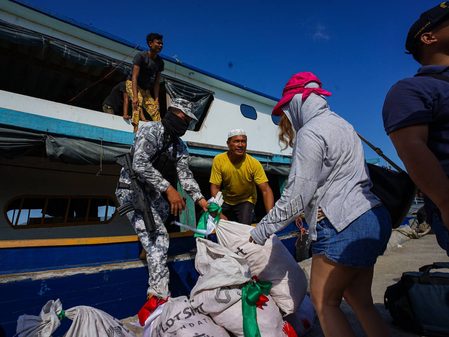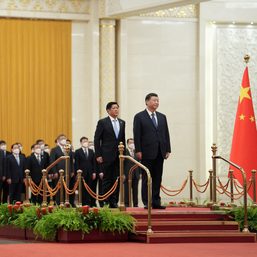SUMMARY
This is AI generated summarization, which may have errors. For context, always refer to the full article.
![[New School] Water over the bridge: China and their water cannons in the West Philippine Sea](https://www.rappler.com/tachyon/2024/02/water-under-bridge-february-17-2024.jpg)
Just a few days before Christmas, on December 8, we embarked on our journey aboard the M/V Kapitan Felix Oca for the first civilian convoy mission to the West Philippine Sea. It was organized by the Atin Ito Coalition, led by the Akbayan Party and by different civil society organizations, set out to deliver Christmas cheer to the frontliners guarding our national waters. It was the first time civilians — students, activists, farmers, fisherfolk, and indigenous peoples — proactively asserted our rights to the West Philippine Sea.
![[New School] Water over the bridge: China and their water cannons in the West Philippine Sea](https://img.youtube.com/vi/Bl7r3sWE4IA/sddefault.jpg)
It was also the first time that I’d been on a ship, and the bridge was my favorite deck because you can see everything that lies ahead on the horizon. The bridge is the highest deck where the ship’s steering wheel is located. That is why it is also the frequent target of the Chinese Coast Guard’s water cannon — when you flood and destroy the bridge, the whole ship goes down.
But some have argued that it is already water under the bridge. That it is futile to resist because we are weak. Maybe they are correct because Chinese aggression in the West Philippine Sea had always been surreal to me from the news about their water cannons, naval barricades, to their intentional ramming. Their actions do not discriminate whether you are a Coast Guard or an unarmed fisherman with your small boat.
Months have passed since the mission ended. We have returned to where we were before, but it’s not water under the bridge. We can never settle any bilateral dispute when the other party occupies the disputed waters and harasses us. Chinese encroachment on our waters remains a reality, and our experiences have proven this.
Before heading directly to Ayungin Shoal, we were set to rendezvous with Ate Paeng, our civilian commander, and the rest of the volunteers for a security briefing and a send-off. Upon arriving there, unsettling news met us: the Chinese Coast Guard had fired water cannons at two BFAR ships on their resupply mission. Another bridge had been flooded by water. Despite this, our security briefing and send-off underscored our mission’s peaceful intent — to spread Christmas cheer in the West Philippine Sea, avoiding confrontation.
After the send-off, we reboarded the M/V Kapitan Felix Oca at midnight, now accompanied by a smaller supply boat, the MV Chowee, ready to officially begin our mission. Our plan was simple: meet up with the three Philippine Coast Guard vessels serving as our security escort, navigate through the Ayungin Shoal, and drop off the supplies at Lawak Island. Yet, our journey was anything but simple.
We awoke to troubling news: a routine AFP rotation and resupply mission had been harassed by Chinese forces. Called to the bridge to assist Ate Paeng, I grasped the satellite phone in the sweltering heat, awaiting confirmation from headquarters. The news was confirmed: AFP Chief of Staff General Romeo Brawner Jr. was involved in the incident, necessitating the redirection of two out of our three Philippine Coast Guard escorts to respond, leaving BRP Melchora Aquino for our protection. While the sea was calm, the water over us from their cannons is not.
Our expectations had prepared us for a confrontation near Ayungin Shoal in the dead of night, yet daylight brought the unforeseen. At 3:40 pm, amidst an ongoing Mass, the silhouette of the People’s Liberation Army destroyer Changsha 173 appeared on the horizon. Moments later, a Chinese Coast Guard ship emerged, its sudden appearance halting the service. I was at the bridge when everything happened so fast. However, nothing could beat the speed of the Chinese Coast Guard turning its bow towards us, with 21 knots (39 km/h) when it was only a couple of miles away from us. The threat of it ramming us or hitting us with a water cannon was only a few minutes away. It became more vivid with every passing second. That was when our captain decided to turn and go back.
As the sun set, our ship may have been whole and unharmed, but the feeling of dark defeat was felt by everyone aboard. We slept feeling disappointed, dejected, and aggrieved. China and its water cannons had proven to be more powerful than I thought — without even shooting its cannons, it devastated the morale of our people. How much more if they had also hit our bridge, just like during the unarmed BFAR resupply mission or the AFP RORE mission where even the AFP Chief of Staff was present?
However, just like everything else, the night also ended. By morning, we learned that the MV Chowee had successfully snuck around to deliver the Christmas supply to Lawak Island. It might not have been all according to plan, but the mission achieved what it wanted — to deliver Christmas cheer to our frontliners. It was poetic — the smaller ship succeeded compared to the bigger force.
Approaching El Nido, several local fishing boats welcomed us, reigniting a spark of hope that this was not the end. I picked up the megaphone and initiated a flash protest right there and then. It was more than a protest to rebuke China or to pressure the government to take action. It was also more than a regular protest, not because it was held in the West Philippine Sea, but because it was a celebration of the success of our mission amidst the challenges we faced.
But our struggle remains a reality for our brothers in the West Philippine Sea. It remains a reality for us. This broader struggle our mission represents remains far from just water under the bridge. It’s a testament to the resilience, unity, and undiminished spirit of those standing up for their rights and for what is justly ours. The waters may rise, but so does our resolve. We are not yet at the point of flooding; we will not abandon ship. – Rappler.com
James Stephen Balbuena was one of the youth leaders of the convoy and is a senior BA Political Science student from the University of the Philippines Diliman. He is part of BUKLOD CSSP, Akbayan! Youth, and the Student Council Alliance of the Philippines.
Add a comment
How does this make you feel?









There are no comments yet. Add your comment to start the conversation.